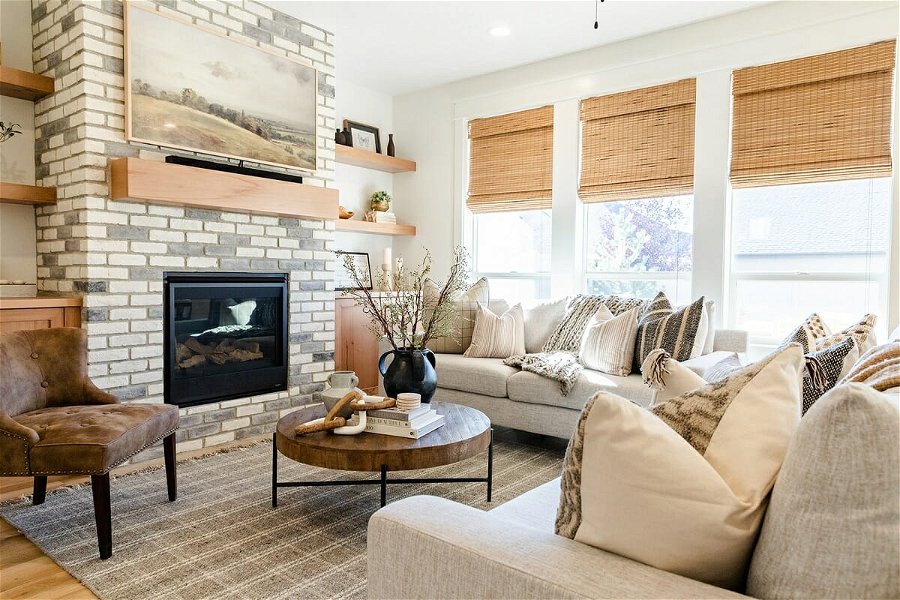Color, Texture, and Light: Elevating Living Room Interiors
The Impact of Color: Choosing the Right Palette Color is a fundamental element in interior design, playing a pivotal role in setting the ambiance and mood of a living room. The psychological effects of color are well-documented, with different hues eliciting various emotional responses. For instance, blues and greens often evoke a sense of calm…
The Impact of Color: Choosing the Right Palette
Color is a fundamental element in interior design, playing a pivotal role in setting the ambiance and mood of a living room. The psychological effects of color are well-documented, with different hues eliciting various emotional responses. For instance, blues and greens often evoke a sense of calm and tranquility, making them ideal for creating a relaxing environment. On the other hand, warm colors like reds, yellows, and oranges can stimulate energy and warmth, which may be suitable for spaces meant for socializing and activity.

Choosing the right color palette involves considering the desired atmosphere of the living room. A neutral palette, for example, can create a sophisticated and timeless look. Shades of beige, white, and gray serve as a versatile foundation that can easily be accented with pops of color. Accent colors can be strategically introduced through furniture, throw pillows, art pieces, and other decor items. This approach allows for flexibility, as accent colors can be changed seasonally or according to evolving tastes without a complete overhaul of the space.
Balancing neutral tones with accent colors is crucial for creating harmony in the living room. Too much of either can lead to a space feeling either too bland or overly chaotic. A well-balanced color scheme often involves a dominant color, a secondary color, and one or two accent colors. For example, a living room might feature neutral walls and a sofa in a subtle shade, complemented by vibrant throw pillows and a statement rug.
Implementing color through different elements of the room—such as walls, furniture, and decor—can significantly enhance the overall design. Painted walls or wallpaper in a chosen color palette can set the backdrop, while furniture in complementary or contrasting hues adds depth. Decor items like vases, artwork, and textiles further reinforce the color scheme, creating a cohesive look.
Popular color schemes that elevate living room interiors include monochromatic designs, which use varying shades of a single color, and complementary schemes that pair colors opposite each other on the color wheel. Analogous schemes, using colors next to each other on the wheel, also create a harmonious and visually pleasing effect. Each of these approaches can be tailored to fit the unique style and atmosphere desired for the living room.
Incorporating Texture and Light: Creating Depth and Warmth
Texture and light play pivotal roles in transforming a living room into a space that is both visually engaging and inviting. The thoughtful inclusion of varied textures—such as wood, fabric, and metal—can significantly enhance the depth and interest of a space. Wood, with its natural grains, introduces an organic warmth, while fabrics like velvet or linen bring softness and comfort. Metals, whether polished or matte, contribute a sleek, modern edge that can contrast beautifully with softer elements.

Lighting is equally crucial in creating a dynamic and warm ambiance. Natural light is the most desirable, as it not only illuminates a room but also enhances the colors and textures within it. Positioning furniture to capitalize on natural light can make the room feel more spacious and welcoming. Additionally, a well-thought-out lighting plan that includes ambient, task, and accent lighting can further enrich the atmosphere. Ambient lighting provides overall illumination, task lighting focuses on specific activities like reading, and accent lighting highlights architectural features or artwork.
Layering both texture and lighting is essential to achieving a cozy and inviting living room. Start by mixing various textures to create a rich, tactile environment. For instance, a leather sofa paired with a knitted throw and a metal coffee table can create a balanced yet diverse aesthetic. Similarly, layering lighting involves combining different types of fixtures and sources. A chandelier or pendant light can serve as a focal point, while table lamps and wall sconces add layers of light that can be adjusted to suit different moods and activities.
When selecting and arranging lighting fixtures and textured elements, consider their placement and how they interact with each other. For example, placing a textured rug beneath a well-lit seating area can draw attention to the space while adding comfort and visual interest. Additionally, using dimmers allows for flexible lighting control, enabling you to adjust the ambiance according to the time of day or occasion.
In summary, incorporating a variety of textures and a strategic lighting plan can significantly elevate the aesthetic and functional appeal of a living room. By thoughtfully combining these elements, you can create a space that is not only stylish but also warm and inviting.











